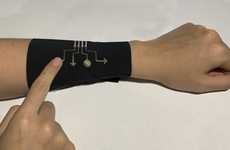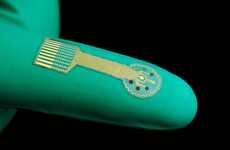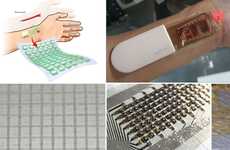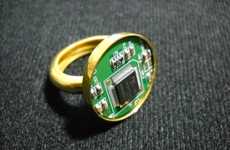
The Epidermal Electronic System has Implications for Health
Amelia Roblin — August 14, 2011 — Tech
The concept of embedding computer chips beneath the flesh creeps more than a few people out, but in terms of reaping the benefits of such a perceptive scheme, the Epidermal Electronic System is likely to appeal more to the masses.
John Rogers and a team of brilliant researchers and technologists have developed a flexible circuit that's contained within a piece of water soluble plastic and can be applied to the surface of you skin with a dab of H2O and some pressure in the exact same way that one pastes on a temporary tattoo. The pliant material of the Epidermal Electronic System (EES) is able to stretch in every direction with your moving flesh.
Implications - The epidermal-integrated sensors allow for the tracking of patients' vital signs, but the invention also has great potential for video gaming technologies and can be combined with RFID tags, LEDs, wireless antennas, transistors, photodetectors, solar cells and capacitors.
John Rogers and a team of brilliant researchers and technologists have developed a flexible circuit that's contained within a piece of water soluble plastic and can be applied to the surface of you skin with a dab of H2O and some pressure in the exact same way that one pastes on a temporary tattoo. The pliant material of the Epidermal Electronic System (EES) is able to stretch in every direction with your moving flesh.
Implications - The epidermal-integrated sensors allow for the tracking of patients' vital signs, but the invention also has great potential for video gaming technologies and can be combined with RFID tags, LEDs, wireless antennas, transistors, photodetectors, solar cells and capacitors.
Trend Themes
1. Epidermal Electronic System - The development of EES brings to light an opportunity for a new generation of wearable technology to evolve that can track physical health, fitness, and environmental changes that can be applied to medical services, gaming technologies and beyond.
2. Flexible Circuits - Flexible circuitry technology has the potential to disrupt traditional rigid PCBs environments, enabling the creation of new hardware with more compact components that can conform to different shapes and applications, opening up opportunities in 3-D printing, sensors, and wearables.
3. RFID Tags and Leds - Advances in RFID tags, LEDs, and other components can be seamlessly integrated with the EES enabling the creation of smart skin applications that can interact with the environment, providing medical aid, detecting hazardous environments, and even enhancing personal style and fashion.
Industry Implications
1. Biotechnology - The EES could revolutionize the healthcare industry by facilitating the development of new medical devices that detect changes in a patient's health and vital signs, improving treatment outcomes, and allowing monitoring of patient's using remote capabilities.
2. Gaming - The EES also has the potential to revolutionize the gaming industry by providing a more immersive gaming environment in which sensors can detect even the slightest movements of gamer's muscles and respond accordingly, giving rise to new types of games and gaming accessories that can be worn directly on the skin.
3. Electronics - The development of EES brings new opportunities for innovative printing processes, flexible electronic components, and smart textiles that could be used in medical applications, fashion industries, and even military applications by providing soldiers with real-time data on their health and the environment.
3.7
Score
Popularity
Activity
Freshness























